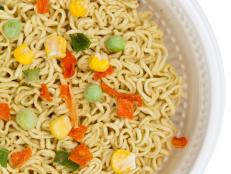Untangling the Facts About Instant Ramen Noodles

We know that instant ramen noodles — that cheap college-student staple — probably don’t qualify as a health food, but exactly how bad for us are they?
A 2014 study by researchers at Harvard School of Public Health found that women who ate instant ramen noodles at least twice a week were at a 68 percent higher risk for metabolic syndrome – a group of conditions including elevated blood pressure, cholesterol and blood sugar; obesity and other factors that increase the risk of heart disease, stroke and diabetes. So, you know, not good.
“Instant ramen is notoriously high in sodium,” explains Michelle Dudash, RDN, Cordon Bleu-certified chef and author of Clean Eating for Busy Families, noting that some brands contain 72 percent of the daily-recommended sodium limit per package.
The packaged noodles are also made with refined grain flour, fried in palm oil, and are hardly redeemed by the teensy bit of dehydrated vegetables they contain. Consequently, Dudash puts them squarely in the “unhealthy food” category. But, she adds, “one of the leading brands of instant ramen noodles offers a 35-percent-less sodium option, so that is a move in the right direction.”
While Dudash says it’s OK to eat instant ramen on the occasional camping trip or sick day, in general, it’s not something she suggests routinely chucking in your shopping cart at the grocery store. And in the rare instance that you do indulge, she suggests restricting consumption to only half the package, sticking to varieties that are lower in sodium, and boosting the “health” factor by adding your own ingredients, such as sautéed vegetables or a lean protein, such as chicken or edamame.
By and large, though, “You’re much better off buying a can of soup filled with vegetables, whole grains, and lean protein like beans or chicken,” Dudash says. “Or if you’re craving a bowl of Asian noodles, boil some brown rice noodles or buckwheat noodles, pour some reduced-sodium or homemade broth on top and add sautéed vegetables and edamame.”
Good to have our tangle of noodle knowledge set straight.
Related Links:
Amy Reiter is a writer and editor based in New York. Her work has appeared in publications including The Los Angeles Times, The New York Times, The Washington Post, The Daily Beast, Glamour and Marie Claire, as well as Salon, where she was a longtime editor and senior writer.
*This article was written and/or reviewed by an independent registered dietitian nutritionist.
























